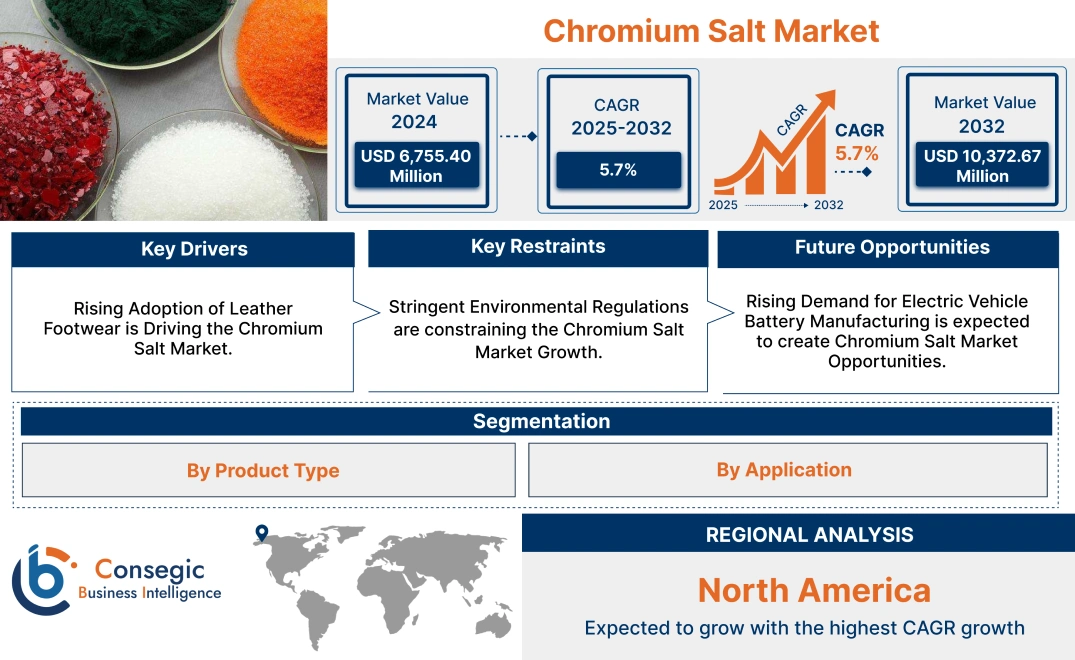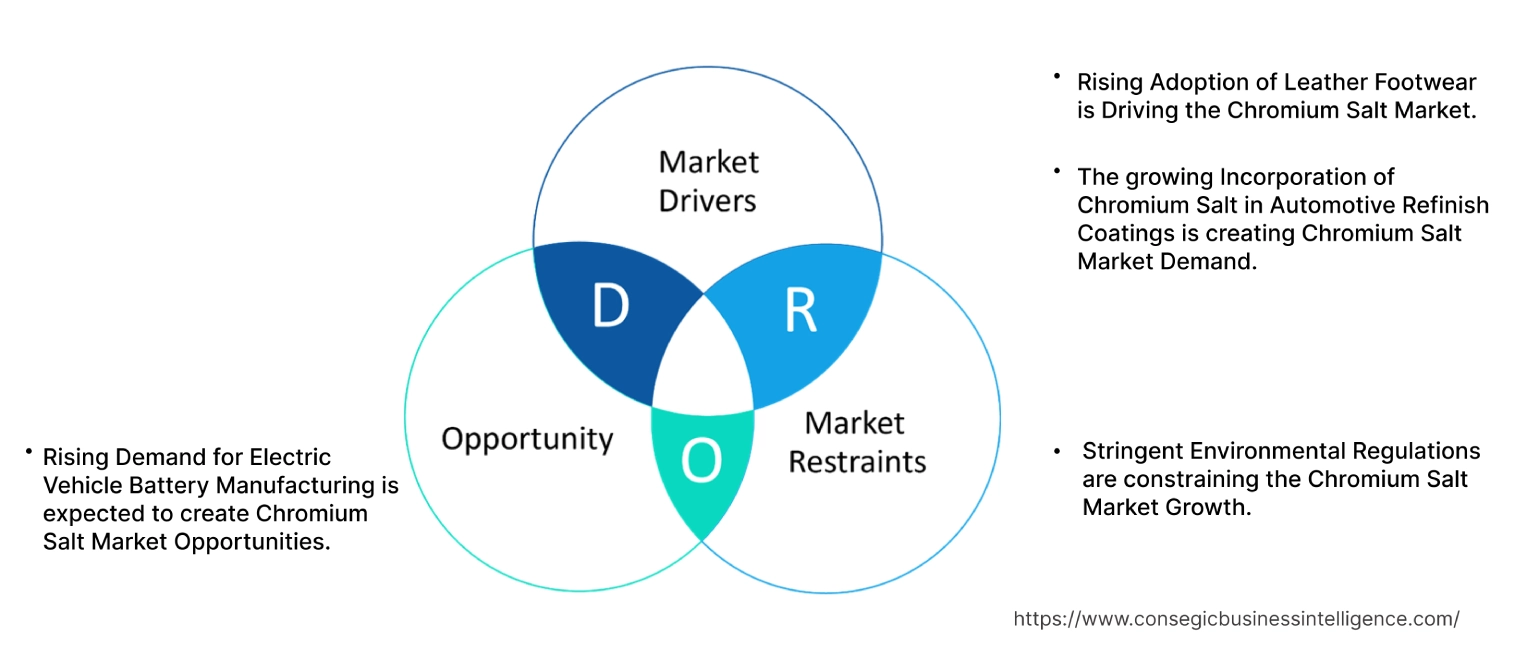- Summary
- Table Of Content
- Methodology
Chromium Salt Market Size:
Chromium salt market size is estimated to reach over USD 10,372.67 Million by 2032 from a value of USD 6,755.40 Million in 2024, growing at a CAGR of 5.7% from 2025 to 2032.
Chromium Salt Market Scope & Overview:
Chromium salt is a group of inorganic compounds containing chromium ions combined with other elements or ions such as chloride, nitrate, sulfate, or oxide. It includes different types such as basic chromium sulfate, chromium oxide, sodium chromate, chromium chloride, and others. Due to its ability to enhance durability, corrosion resistance, and flexibility, chromium salt is used in a wide range of applications such as leather tanning, pigments & dyes, coatings & paints, wood preservatives, and others. Further, in leather tanning, it is extensively used to produce high-quality and durable leather. Moreover, the growing leather manufacturing sector and the rising popularity of durable, wear-resistant coatings in the automotive sector are further driving the chromium salt market.
Key Drivers:
Rising Adoption of Leather Footwear is Driving the Chromium Salt Market.
Basic chromium sulfate is a type of chromium salt formed by combining chromium sulfate with hydroxide ions. The basic nature of chromium sulfate is essential in leather footwear for producing high-quality, soft leather by enhancing its durability, strength, and flexibility. The use of leather footwear is rising due to growing disposable incomes, shifting consumer preferences, and the popularity of luxury and fashion items.
- For instance, in 2022, according to the Council for Leather Exports, in India, the export of leather footwear increased by 37% as compared to the year 2021. The increasing adoption of leather footwear is driving the market, as chromium salt, particularly basic chromium sulfate is extensively used in leather footwear to enhance durability, flexibility & wear resistance.
Thus, the rising adoption of leather footwear is leading to chromium salt market demand due to the ability to produce high-quality and durable leather.
The growing Incorporation of Chromium Salt in Automotive Refinish Coatings is creating Chromium Salt Market Demand.
Chromium salt, particularly chromium chloride and chromium oxide is extensively used in automotive refinish coatings to create long-lasting and durable metal surfaces. Further, chromium chloride is widely used to produce vibrant green, red, and yellow pigments, which are crucial in automotive refinish coatings. The need for automotive refinish coatings is rising due to rising vehicle ownership and the popularity of customization.
- In 2023, according to the American Coatings Association, sales of automotive refinish coatings in the United States increased by 6.9% as compared to the year 2022. Chromium salt, particularly chromium chloride and chromium oxide is widely used in automotive refinish coatings to produce colored pigments and long-lasting metal surfaces. The growing sales of automotive refinish coatings are further driving the market.
As a result, the use of chromium chloride and chromium oxide is growing in automotive refinish coatings for producing durable and wear-resistant metal surfaces leading to chromium salt market expansion.
Key Restraints:
Stringent Environmental Regulations are constraining the Chromium Salt Market Growth.
Environmental regulations serve as significant restraints on the market, as they require stringent compliance during the manufacturing, usage, and disposal of properties. Regulatory frameworks such as REACH (Registration, Evaluation, Authorization and Restriction of Chemicals) in Europe and the Environmental Protection Agency (EPA) in the United States and others are imposing regulations on chromium salt manufacturers. It imposes regulations to limit toxicity, manage chemical waste, and ensure product safety standards. These measures increase operational costs for the manufacturers. Additionally, the chromium salt production processes are highly toxic and pose significant environmental and health risks. With the growing focus on sustainability, manufacturers are required to adopt eco-friendly practices, invest in cleaner technologies, and explore renewable sources. This results in high investment costs and delays in the production process. Thus, environmental regulations are restraining the chromium salt market, due to regulatory standards and high cost.
Future Opportunities :
Rising Demand for Electric Vehicle Battery Manufacturing is expected to create Chromium Salt Market Opportunities.
An electric vehicle (EV) battery is a type of rechargeable battery used to store energy in electric vehicles. Chromium salt, particularly chromium chloride is being used in electric vehicle battery manufacturing due to its ability to enhance efficiency by improving electrode stability and charge-discharge efficiency. The demand for EV battery manufacturing is growing due to a rising shift towards sustainability, government regulations & incentives, cost reductions, and shifting consumer preferences towards reducing carbon emissions.
- For instance, in 2024, according to Faraday Institution, demand for EV battery manufacturing capacity in the United Kingdom will increase by 90% in 2026 as compared to the year 2024. Chromium salt, particularly chromium chloride is being incorporated in EV battery manufacturing to improve battery performance by improving structural stability of electrodes and by reducing degradation.
Thus, the rising use of electric vehicle battery manufacturing is creating chromium salt market opportunities to enhance efficiency and improve the structural stability of electrodes.
Chromium Salt Market Segmental Analysis :
By Product Type:
By product type, the market is divided into basic chromium sulfate, chromium oxide, sodium chromate, chromium chloride, and others.
Trends in Product Type:
- As per chromium salt market trends, basic chromium sulfate is widely used in the leather industry to produce high-quality, durable leather.
- The use of chromium chloride is rapidly expanding due to its ability to create high-quality, corrosion-resistant coatings on metals as per market trends.
The basic chromium sulfate accounted for the largest market share in the year 2024.
- Basic chromium sulfate is a type of chromium salt formed by combining chromium sulfate with hydroxide ions.
- Basic chromium sulfate is a widely used chromium salt, primarily due to its incorporation in the leather industry.
- It is widely used for producing high-quality, durable leather, especially for goods like shoes, gloves, and upholstery.
- The use of basic chromium sulfate is further fueled by the expanding proliferation in the fashion, automotive, and furniture industries.
- Further, companies are expanding leather production facilities, which use basic chromium sulfate for the leather tanning process to produce high-quality, durable leather.
- For instance, in 2024, Aupen a Singapore-based leather bag brand announced a partnership with luxury conglomerate LVMH Metiers d’Art. The partnership will include access to French leather production facilities owned by LVMH which uses basic chromium sulfate for the tanning process in leather.
- Thus, basic chromium sulfate is widely used chromium sulfate due to its incorporation into the leather tanning process.
The chromium chloride is expected to grow at the fastest CAGR over the forecast period.
- Chromium chloride is a type of chromium salt formed by combining chromium with chlorine.
- The chromium chloride is rapidly expanding within the chromium salt market, with increasing use driven by diverse industrial applications.
- Chromium chloride is extensively used in electroplating due to its ability to create high-quality, corrosion-resistant coatings on metals.
- Additionally, it is gaining adoption in catalysis, where it is used in the production of chemicals, petrochemicals, and polymers.
- The growing emphasis on sustainable energy has also contributed to the market proliferation, with chromium chloride being used for use in lithium-ion batteries and other energy storage such as thermal energy storage and hydrogen storage.
- Thus, the use of chromium chloride is experiencing rapid proliferation, driven by corrosion resistance and catalyst properties as per market trends.
By Application:
By application, the market is divided into leather tanning, pigments & dyes, coatings & paints, wood preservatives, and others.
Trends in Application:
- According to chromium salt market trends, chromium oxide is extensively used in decorative paints due to its excellent wear-resistant properties.
- The use of chromium salt in pigments & dyes is rising to produce long-lasting and colored pigments as per market trends.
The leather tanning accounted for the largest market share of 33.21% in the year 2024.
- Chromium salt is essential in leather tanning for producing high-quality leather by enhancing its durability, strength, and flexibility, making it suitable for in wide range of products such as shoes, bags, upholstery, and automotive interiors.
- Chromium salt, especially basic chromium sulfate is used to produce leather which is resistant to heat, water, and wear, which is crucial for the fashion and automotive industries.
- Further, companies are investing in the leather tanning sector, driving the need for chromium salt to produce high-strength, durable leather.
- For instance, in 2024, Pidilite Industries Limited collaborated with Syn-Bios, which uses basic chromium sulfate for leather tanning, further driving market growth. In this collaboration, Pidilite Industries Limited will handle sales and distribution of Syn-Bios products in India, Sri Lanka, Bangladesh, Nepal, and Vietnam. Both companies will also engage in technical collaboration to offer comprehensive solutions for the leather sector.
- Thus, chromium salt is widely used in leather tanning to enhance the durability and quality of the leather.
The pigments & dyes are expected to grow at the fastest CAGR over the forecast period.
- The use of chromium salt in pigments & dyes plays a crucial role, particularly in industries like paints & coatings, ceramics, and plastic.
- Chromium salts, especially basic chromium sulfate and chromium chloride are widely used to produce vibrant green, red, and yellow pigments, which are highly valued for their intensity.
- Chromium salt-based dyes are also used in ceramic glazing and plastic coloring, where their heat resistance and color are beneficial.
- The use of chromium salt in pigments & dyes is also gaining traction in decorative paintings for the need for durable and long-lasting pigments.
- Thus, use of use of chromium salt in pigments & dyes is growing, supported by the production of high-quality pigments & dyes as per market trends.
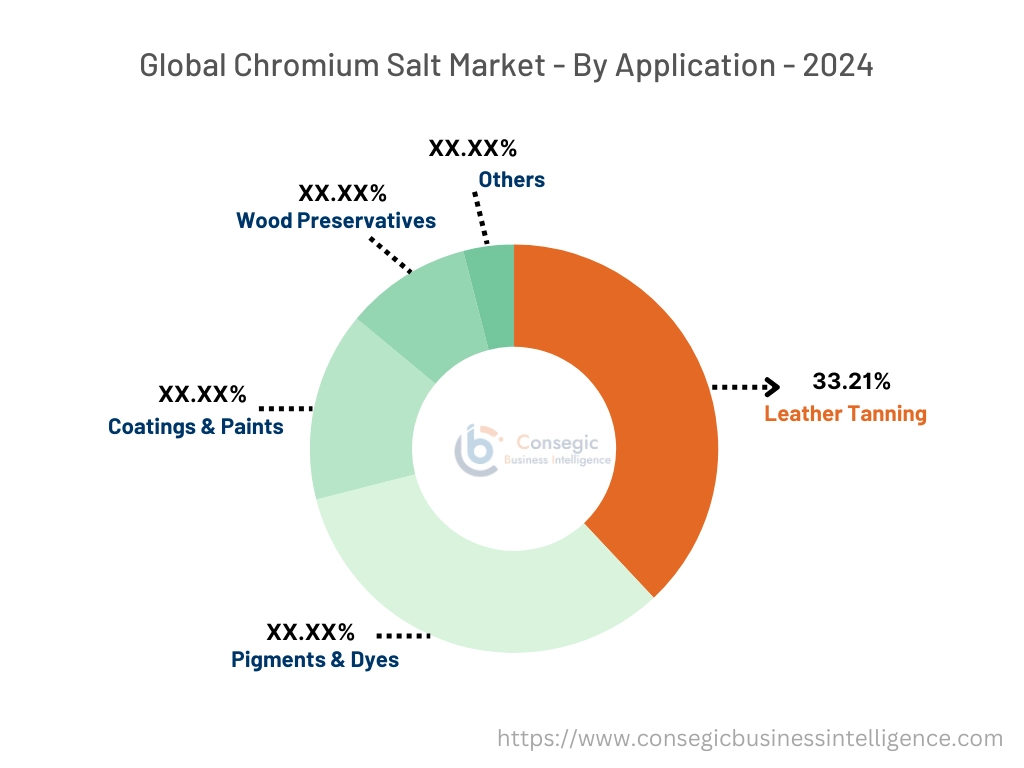
Regional Analysis:
The regional segment includes North America, Europe, Asia Pacific, the Middle East and Africa, and Latin America.
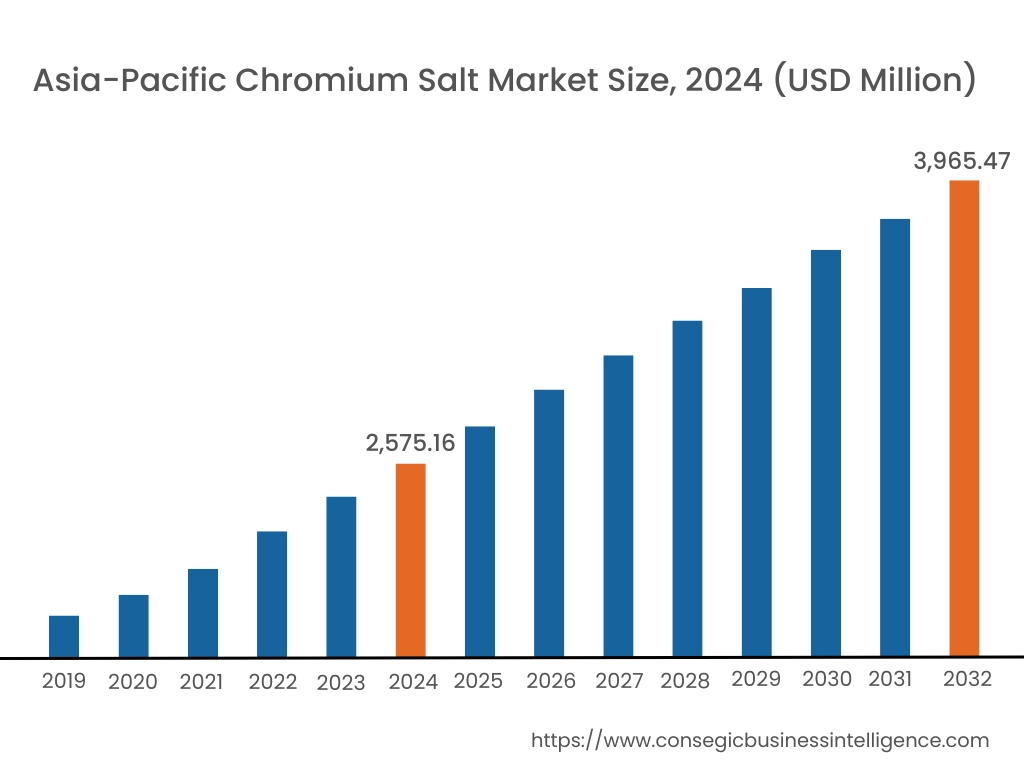
In 2024, Asia Pacific accounted for the highest market share at 38.12% and was valued at USD 2,575.16 Million and is expected to reach USD 3,965.47 Million in 2032. In Asia Pacific, China accounted for the highest market share of 23.61% during the base year of 2024. As per market analysis, the chromium salt market share of the Asia-Pacific region is driven by expanding leather manufacturing facilities and industrial developments. The automotive sector in this region is also creating demand for long-lasting & wear-resistant coatings where chromium salt particularly chromium chloride and chromium oxide is used, further driving the market. Countries like China, India & Japan are major contributors to this region due to high production as well as consumption of leather goods such as leather, bags, shoes, and others.
- For instance, in 2022, according to the Indian Leather Technologists’ Association, China exported 10.23 million leather garments valued at USD170 million, higher by 18.2% and 20.2% respectively over 2021. Chromium salt, particularly basic chromium sulfate is essential in leather goods for producing high-quality leather by enhancing its durability, strength, and flexibility.
Thus, the Asia-Pacific region is leading in the market due to its well-established leather manufacturing infrastructure and expanding automotive sector as per the analysis.
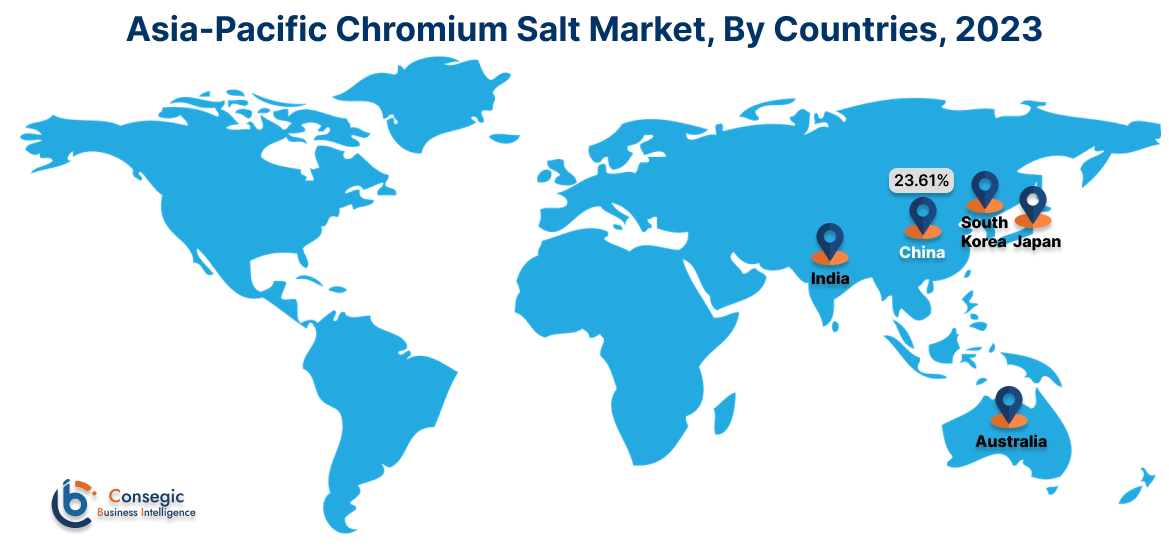
North America is expected to witness the fastest CAGR of 5.9% over the forecast period of 2025-2032. According to market analysis, North America’s chromium salt market share is experiencing rapid proliferation in the market, driven by the well-established leather manufacturing and construction sector. The region benefits from a strong leather sector, which remains a significant consumer of chromium salt used in shoes, bags, and others. The growing emphasis on durable automotive coatings in the region is further accelerating the market. The region is also experiencing rapid construction and industrial developments, which is further driving the need for chromium salt to ensure high-quality & long-lasting paints and coatings. Thus, North America is experiencing chromium salt market growth, driven by technological innovation and the presence of major manufacturers.
According to chromium salt market analysis, the European region is growing significantly in the market due to well-established automotive and leather manufacturing sectors. The European countries are experiencing growth in the manufacturing of paints & coatings further fueling the market growth. Countries like France, the United Kingdom, and Russia are key contributors due to the major production of leather goods such as leather bags, shoes, and others. Also, the government in this region is implementing stringent environmental regulations driving the transition towards sustainable and eco-friendly processes for chromium salt production. Moreover, European manufacturers are investing heavily in research and development of advanced leather-based products, further driving the chromium salt market expansion.
According to chromium salt market analysis, the market is expanding in the Middle East and Africa region driven by rapid construction and the growing automotive manufacturing sector. In countries like Dubai, UAE, and South Africa the market is propelling due to rapid adoption of leather-based goods and the expanding automotive sector. It is fueling the adoption of chromium salt in leather tanning, pigments & dyes, paints & coatings, and others. The region is also experiencing rapid growth in construction which focuses on chromium salt-based paints and coatings due to their long-lasting and high-quality properties. The region is expected to grow significantly in the market, supported by industrial developments and government support.
According to market analysis, Latin America is witnessing moderate growth in the market, driven by expanding leather manufacturing activities, and rising construction and infrastructure development. Key countries like Brazil, Mexico, and Argentina lead the market due to their strong automotive and leather manufacturing sectors. The growing automotive market is a significant contributor, with increasing demand for chromium salt for long-lasting and high-quality automotive coatings. Environmental regulations are encouraging the adoption of bio-based processes for the production of chromium salt in the region, driving market opportunities. However, challenges such as supply chain complexities, rising raw material costs, and regulatory barriers impact the growth of the market in the region.
Top Key Players and Market Share Insights:
The chromium salt industry is highly competitive with major players providing products to the national and international markets. Key players are adopting several strategies in research and development (R&D) and product innovation to hold a strong position in the global chromium salt market. Key players in the chromium salt industry include-
- Merck KGaA (Germany)
- Thermo Fisher Scientific Inc. (United States)
- Bayer (Germany)
- Chemtura Corporation (United States)
- Lanxess AG (Germany)
- Cymit Química S.L. (Spain)
- Sun Industries (Australia)
- Loba Chemie Pvt. Ltd. (India)
- Central Drug House (India)
- Ciba Speciality Chemicals (Switzerland)
Recent Industry Developments :
Innovation:
- In 2023, the University of Hong Kong developed high corrosion-resistant stainless steel that maintains excellent corrosion resistance even in severe corrosive environments. This stainless steel is made from chromium oxide, a type of chromium salt.
Chromium Salt Market Report Insights :
| Report Attributes | Report Details |
| Study Timeline | 2019-2032 |
| Market Size in 2032 | USD 10,372.67 Million |
| CAGR (2025-2032) | 5.7% |
| By Product Type |
|
| By Application |
|
| By Region |
|
| Key Players |
|
| North America | U.S. Canada Mexico |
| Europe | U.K. Germany France Spain Italy Russia Benelux Rest of Europe |
| APAC | China South Korea Japan India Australia ASEAN Rest of Asia-Pacific |
| Middle East and Africa | GCC Turkey South Africa Rest of MEA |
| LATAM | Brazil Argentina Chile Rest of LATAM |
| Report Coverage |
|
Key Questions Answered in the Report
How big is the chromium salt market? +
In 2024, the chromium salt market is USD 6,755.40 Million.
Which is the fastest-growing region in the chromium salt market? +
North America is the fastest-growing region in the chromium salt market.
What specific segmentation details are covered in the chromium salt market? +
Product type and application are covered in the chromium salt market.
Who are the major players in the chromium salt market? +
Merck KGaA (Germany), Thermo Fisher Scientific Inc. (United States), and Cymit Química S.L. (Spain) are some of the major players in the market.
